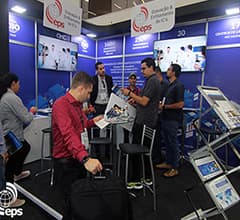Home > News & Blog > Component Packaging
The Role of Component Packaging in High Speed Manufacturing | Insights from Colin Lynch

In this episode, our CMO Ciara McCarthy sits down with Colin Lynch, CEO of EPS Global, to explore the world of component packaging and its critical role in high-speed manufacturing. Colin explains the benefits of tape-and-reel packaging, including faster setup times, increased efficiency, and cost savings for manufacturers. He dives into how industries like MedTech, automotive, and industrial manufacturing can optimize their production lines by transitioning from trays to tape.
Discover how EPS Global is innovating with custom tape solutions, discrete taping, and even wafer taping for micro-components as small as 300 microns squared. Colin also shares insights into the challenges of component shortages, the logistics of tray-to-tape conversions, and the exciting advancements shaping the future of the industry.
Transcript of The Evolution of Tape and Reel Packaging in Modern Manufacturing
Ciara: I'm here today with Colin Lynch who is the CEO of EPS Global and we're here today to talk about component packaging.
To start, what are the benefits of component packaging for devices onto tape?
Colin: The simplest answer is that tape facilitates high-speed pick-and-place operations. All of our customers are effectively contract manufacturers, including OEMs who act as internal contract manufacturers for their own companies when building in-house. They operate many production lines assembling printed circuit boards, each with numerous part numbers. With such a diverse mix in production, they're all measured by their ability to achieve the highest possible throughput on the assembly line.
A single production line requires $2,000,000 to $3,000,000 in capital equipment for the pick-and-place machines, known as chip shooters, that place components onto the board. These machines are measured by their throughput capacity, but with so many different part numbers, setup time becomes crucial. Each facility has several lines, and the staff needed to set up and maintain each operational line significantly impacts both CapEx and OpEx.
The critical point about this setup is that all chip shooters are designed specifically for tape. They operate at optimal speed when fed with tape, as the large quantity packaging—thousands of pieces per reel—allows for quicker setup. You can pre-assemble off the line, set up with a single click, and then run longer production cycles thanks to the large quantities available per reel.
Let me give you an example: In a chip shooter, you typically have 16 slots. For a simple printed circuit board assembly with 32 different part numbers, you need two chip shooters side-by-side, with 16 parts in each. However, if just one of those parts is only available in trays, each tray takes up four slots instead of a single tape slot. This means you suddenly need three chip shooters. While this is a simplified example, it illustrates how trays generally increase the space requirements in your chip shooter and raise your capital expenditure.
The situation becomes more challenging with multiple tray-based components. With two parts requiring trays, you're reduced to eight available slots, or you need to implement a carousel to rotate between trays. This adds both capital costs and time to your operation, as carousels operate much slower than reels. Every time you work with trays in a production line, you're forced to compromise on either capital or operational expenses, which is why manufacturers strive for an all-tape setup.
There's also a quality consideration to consider. Components in tape remain sealed until use, whereas with trays, you must unpackage the tape to transfer parts into carousel trays. This creates issues like atmospheric exposure and potential requirements for baking components. Additionally, trays typically hold smaller quantities than their reel equivalents, making setup more complex. You need to continuously feed the tray stacker, requiring more frequent human oversight compared to a reel of 5,000 parts. This is why volume manufacturing gravitates toward tape-based solutions – and that's where our business comes in.
Ciara: Essentially we're looking at improvements in speed, efficiency, and productivity, which ultimately translate into cost savings?
Colin: Yes, it's essentially a cost exchange. Our customers pay a per-piece price for tape packaging, but they almost always see the payoff through reduced operational or capital expenses on their side.
Ciara: How can the medical, medtech, pharmaceutical, and agricultural technology industries benefit from custom tape and reel packaging solutions?
Colin: The benefits of taping and reeling aren't specific to any particular vertical market. All our customers benefit in exactly the same way, whether they're in medtech, automotive, contract manufacturing, or industrial sectors. We focus on industries with similar volume economics, and across these sectors, they all see significant benefits from using tape. This includes medtech alongside all other industries.
Ciara: What methods do manufacturers typically use to ship their parts?
Colin: Manufacturers often make products available in tape, which is the most straightforward approach – customers can buy components in the format they'll use them. However, some manufacturers prefer shipping in trays, depending on the components. For larger connectors or components requiring complex packaging, trays are often preferred because they're more robust for long-distance shipping and offer better quality protection. Their square shape also allows for more efficient packaging in long-distance air freight.
Sometimes, during component shortages, parts might only be available in trays, forcing customers to purchase components they'd normally buy in tape format. While manufacturers might push for tray packaging, there's never pressure from the consumer side – customers invariably prefer tape packaging. This creates an ongoing discussion about the cost-benefit of converting components from trays to tape.
In our programming business, for instance, we receive large quantities of components in trays but typically deliver them in tape format. We avoid many of the logistics and quality challenges associated with trays because we're located close to our customers, eliminating the need for long-distance shipments or air freight.
Ciara: Can EPS Global's machines handle the transfer between tape and tray formats in both directions?
Colin: Yes. In our programming services business, we currently tape and reel the majority of products that we program – almost 100% of them. However, our fastest-growing segment is discrete taping and reeling, which involves non-programmed components like die-cast parts, metal parts, connectors, and clasps. This often requires custom tape with specialized pockets to accommodate these components.
In a typical 300-item bill of materials, this might be the last component still needing conversion to tape format. Moving this final part from trays to tape can represent a significant improvement in line efficiency. The cost of conversion is often justified by the productivity gains, as it removes the last hurdle to achieving a fully tape-based production line.
Ciara: What technological advancements are shaping the future of tape and reeling?
Colin: Within EPS, we've made two significant advancements in the last three to four years. First, we now manufacture most of our own tape – something that wasn't true five years ago. This represents a substantial investment in tape manufacturing. Beyond the standard sizes we use for our programming business, which typically requires standardized width and depth, we've developed a range of custom tape for pins, connectors, unusually shaped devices, deeper components, and transformers – items that traditionally weren't suitable for tape packaging.
Our second and latest development is wafer taping, which represents an entirely new business direction. We've developed in-house capabilities to flip, optically inspect, and tape devices as small as 300 microns squared. While this isn't particularly small for wafers, it's tiny compared to our traditional components. This capability is especially important for semiconductor capacitors and other non-programmable chips, making it purely a taping and reeling business.
Currently, while there's significant capacity for this capability in Asia, there's limited capacity in Europe and Mexico – our target markets. We're planning to build out this capability in 2025, which should mark an exciting new chapter for our business.
Ciara: Amazing okay I think that's a really quick run around component packaging.
Glossary of Terms
- Tape and Reel - A packaging method for electronic components where parts are sealed in a carrier tape and wound onto a reel, designed for automated pick-and-place operations.
- Pick-and-Place - The automated process of picking up electronic components and placing them precisely on a printed circuit board during assembly.
- Custom Tape - Specialized carrier tape manufactured to accommodate components with non-standard sizes or shapes, such as connectors or transformers.
- Wafer Taping - A specialized process for packaging semiconductor components directly from wafers into tape and reel format, handling components as small as 300 microns squared.
- Discrete Taping and Reeling - The process of packaging individual, non-programmed components such as die-cast parts, metal parts, and connectors into tape format.










